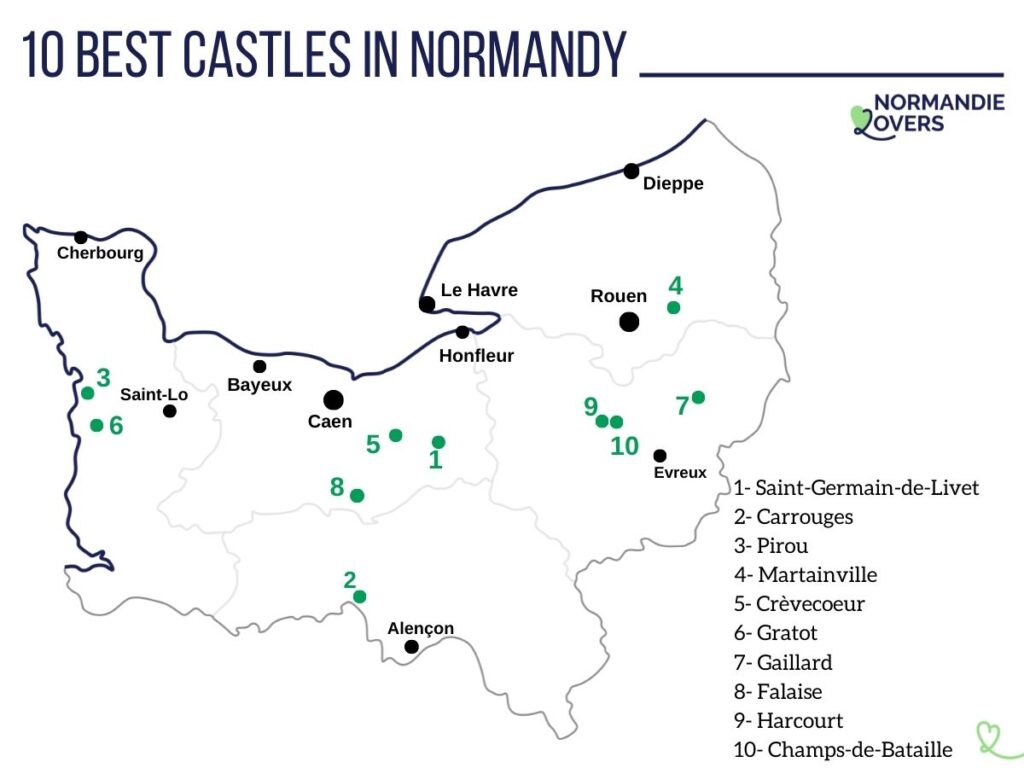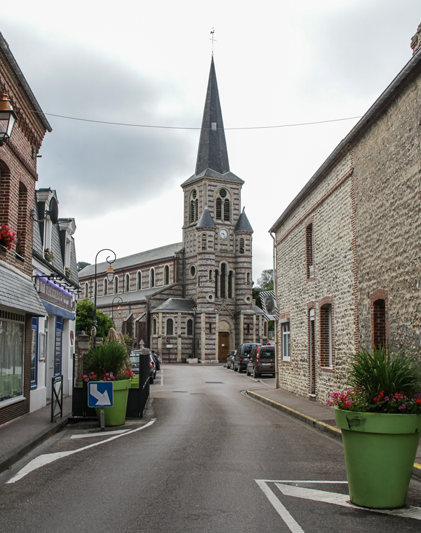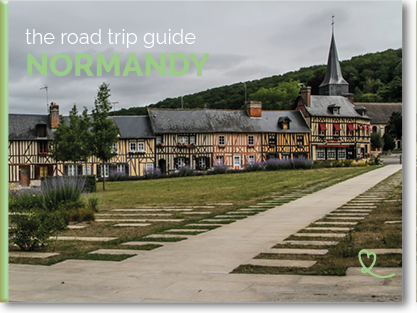In the heart of the Pays d’Auge, the Château de Saint-Germain-de-Livet is a real gem. The château-museum dates back to the 15th and 16th centuries. It combines medieval and Renaissance styles. Its checkerboard facades of stone and brick, its moat and lush parkland make for one of the most charming visits in Normandy.
In this article, you’ll find some useful tips to help you prepare for your visit and have a great time!

This guide is completely independent, based on our experiences. We visited the region anonymously, making our own choices and paying our bills in full.
Why visit the Castle of Saint-Germain-de-Livet
Is the castle worth it? Our opinion:
Yes, the Château de Saint-Germain-de-Livet is definitely worth a visit, for several reasons:
- Its unique architecture combines medieval and Renaissance styles,
- Colorful glazed checkerboard facades,
- Its moats make it a picturesque site,
- Its park and formal gardens add to its charm,
- Inside, we were fascinated by the rich period furnishings and works ofart.
In our opinion, it’s one of the most beautiful châteaux in Normandy, and also our favorite.

Why is the Château de Saint Germain de Livet famous?
The Château de Saint-Germain-de-Livet is renowned for its unique architecture. Its checkerboard facades of stone and green-glazed brick are rare in Normandy. The château is also notable for the works on display by painter Léon Reisener, first cousin ofEugène Delacroix. The painter’s family owned the château in the 19th century.
It has also been awarded the ” Musée de France” label. It is also a listed historic monument.

Our favorite moments
We loved it:
- The medieval timber-framed manor house. This is the oldest part of the château. It dates from the 15th century.
- The frescoes in the Uffizi Room. Long hidden by lime plaster, they were discovered in the 20th century.
- The green glazed bricks of the Renaissance façade and their checkerboard pattern,
- The bucolic charm of the park with its peacocks and swans.

History in brief
The château is located near Lisieux, in Normandy. The first building, the timber-framed manor house, was built in the 15th century. During the Renaissance, a magnificent extension was added, with an arcaded gallery and the famous checkerboard facades of stone and glazed brick we’ve come to admire so much.
In the 19th century, it belonged to the Riesener family, famous for its connection with the artist Léon Riesener. The family’s last heir donated it to the city of Lisieux in 1938. Today, it is a museum exhibiting the family’s heritage.

WHERE TO STAY IN Normandy
We particularly appreciate staying in Normandy:
- Bayeux – our hotels selection
- Honfleur – our hotel selection

For more ideas, take a look at our article on the best places to stay in Normandy.
And if you already have an idea, take a look at our selections:
Access and map: Château de Saint-Germain-de-Livet, Normandy
Where is the castle?
- On the commune of Saint-Germain-de-Livet in Normandy
- Driving time from Lisieux: 10min
- Driving time from Deauville: 45min
- Driving time from Caen: 1h
- Here is a map to help you find your way:

How to get there?
- We advise you to come by car, as it’s probably the most practical way. The castle is isolated.
- However, you can also take the bus from Lisieux station. Once off the bus, it’s a 25-minute walk to the château.
- There are also cycle routes linking Lisieux to the château, notably the Pays d’Auge cycle route. Find out more here.

OUR ADVICE FOR RENTING A CAR IN Normandy
- Compare prices on our preferred platform: DiscoverCars – one of the best rated sites.
- Choose a car that is comfortable enough (distances can be long) but compact (some parking lots and villages are narrow).
- Think of thecomplete insurance (some roads are tortuous and narrow).
- There is a lot of demand, book it early.

Parking
There’s a free parking lot just opposite the entrance to the château grounds, on the church side, alongside the cemetery. Another parking lot welcomes visitors a little further along the same side, opposite an expanse of grass equipped with picnic tables, on the banks of a small stream, the Ruisseau de Lecange.

Useful tips: duration, schedules, eating…
Best time to visit
Visit the Château de Saint-Germain-de-Livet in spring or autumn is particularly pleasant. The colors of the surrounding gardens and Normandy countryside make for a delightful backdrop.
Summer is obviously busier. We advise you to visit in the morning or late afternoon, for greater peace and quiet and to enjoy the softer, more oblique light.
And don’t forget to check the weather forecast before you come – we’re in Normandy!

Length of visit and main difficulties
Allow 2 hours for the visit if you wish to enjoy the gardens and park.
At the end of the tour of the château’s apartments, there’s a narrow stone spiral staircase in the south tower.
Pets are not allowed inside the château.

Advice on how to visit
There’s no particular way to visit. We visited freely. Inside, mediators are on hand to supplement the information available on text panels.

USE OUR GUIDE TO PLAN A
DREAM TRIP TO Normandy
All the information you need for your trip:
- 8 maps that make planning easier
- 160+ pre-selected locations
- Practical advice
- 300+ photos to help you choose

Visiting with children
A child-friendly tour booklet is available free of charge.
Schedules and rates
The château is open from May to November, Tuesday to Sunday, 10.30am to 12.30pm and 2pm to 6pm.
Closed on Mondays
Price: free of charge

Guided tours
- Guided tours are reserved for groups of 13 or more. Find out more here.
- During the summer months, numerous events are organized on the château grounds. Please consult the calendar of events. Find out more here.

Catering
Right next to the château, on the other side of the moat, is a delightful tearoom-crêperie, Restaurant Les 3 Gourmands. Its terrace offers a charming view of the château. The establishment also offers bed & breakfast.
There are also picnic tables by the water, in the meadow behind the parking lot.

Subscribe to our Newsletter
- Get away from it all with Region Lovers’ beautiful destinations!
- Once a month
- Advertising-free
Discover the picturesque, bucolic surroundings
Even before entering the château, we were impressed by the checkerboard pattern of its façade. It’s emblematic of a building that looks like something out of a fairy tale.
Checkerboard facades: glazed bricks and 16th-century stone
This is one of the most distinctive features of Château de Saint-Germain-de-Livet. We loved the geometric pattern alternating between Claire limestone and Pré d’Auge glazed brick, sometimes red, sometimes green. It creates a striking visual effect.

This decorative technique is rare in Normandy. It is typical of 16th-century Renaissance architecture. It bears witness to theItalian influence on French architecture at the time.

This decorative style is a symbol of prestige. It testifies to the refinement and wealth of the owners of the time.
The main gate and its two remarkable turrets
On the other side of the footbridge that spans the moat and replaces the drawbridge, the château’s main entrance is topped by a sculpted portal featuring a psyche.

But what we noticed first were the two admirable cylindrical turrets flanking the gate. With their conical slate roofs, they add a surprisingly enchanting defensive touch.

As you approach, you can see the gable of the medieval manor house, like a thatched cottage attached to the castle.
Exploring the historic pentagonal courtyard
Once through the front door, we entered the château’s courtyard, where we were treated to a number of surprises.
The Renaissance arcade gallery
We found the arcaded gallery very attractive. It, too, bears witness to the Italian influence in French Renaissance architecture. It runs along the east wing of the château, from the entrance pavilion to the south tower.

The gallery is composed of four sleek, basket-shaped coves resting on elegant columns. We liked to imagine the castle’s occupants taking advantage of this sheltered circulation space.

The gallery is very narrow, and from the courtyard we realized just how small the Renaissance part of the château was compared to the medieval part.
The timber-framed medieval manor house
Turning to the medieval manor house next to the entrance pavilion, opposite the Renaissance building, we were surprised by its half-timbered facade. They lend a bucolic thatched cottage style to the whole, and contrast with the much more sophisticated stone and brick facade.

This is the oldest part of the château. It dates from the 15th century. It is highly emblematic oftraditional Norman architecture of the late Middle Ages. We love the half-timbering technique, with its wooden framework visible from the outside.

We particularly liked the west end of the building, with its grey wood cladding. It’s also a magnificent structure that deserves attention.
A must-see tour of the museum and its treasures
We then went inside the château to discover the wonders of the museum. It has been awarded the Musée de France label.
The 16th-century frescoes in the Uffizi Room
We loved these frescoes and, above all, their history. In fact, they were recently discovered during restoration work. They date back to the 16th century and were previously covered with plaster. The restorers were thus able to bring to light these works of art that had been hidden for centuries.

They depict particularly violent scenes, from war to mythology. One of these, painted above a doorway, impressed us greatly. It depicts the beheading of John the Baptist. Although we don’t see John the Baptist’s head on a plate, it does appear at the end of a spike.

The 19th-century apartments of the Riesener-Pillaut family
We were able to appreciate the elegant decor of these apartments. They are decorated with beautiful objects (crockery, tapestries, objets d’art). The same is true of the furniture, some of which was made by the famous cabinetmaker Jean-Henri Riesener.

He was the grandfather of the painter Léon Riesener , some of whose works can also be admired. Léon Reisener was a cousin of Eugène Delacroix, who painted his portrait. The evocation of these illustrious names and the presence of the paintings add a notable artistic dimension to the visit.

Enchanted stroll through the flower-filled park
We finished our visit by taking the spiral staircase of the tour du midi , then the arcaded gallery, before returning to the park.
The elegance of French gardens
The gardens are small in scale, but beautifully enhanced by the site’s vegetation and the presence of the château. They are a perfect example of the elegance and symmetry typical of this style.

We loved the geometric flowerbeds, trimmed hedges and straight paths stretching along the foot of the immense willows. Benches have been installed in the garden, and we were able to take full advantage of the serenity it exudes.
The peaceful charm of a moat
Above all, the presence of the moat adds enchanting charm to this perfect setting. They encircle the château and reflect its checkerboard facades of colored brick. They create a natural mirror that enhances the beauty of the site tenfold.

Strolling along their banks, we enjoyed the serene, picturesque atmosphere of the park to the full. Especially when a pair of swans came to introduce us to their young brood, magnificent baby swans enjoying the coolness of the water.

PLAN YOUR TRIP TO Normandy
Inspiration destinations
- Deciding where to go in Normandy – the best destinations
- Our weekend ideas: best-of, romantic, unusual, seaside, luxury, family
- 16 seaside hotels in Normandy
- The most beautiful charming hotels in Normandy

Best of

Practice
- Where to stay in Normandy – best places and hotels
- See our tips for renting a car at CDG airport, Orly airport, Beauvais airport, Caen, Rouen, Bayeux…






